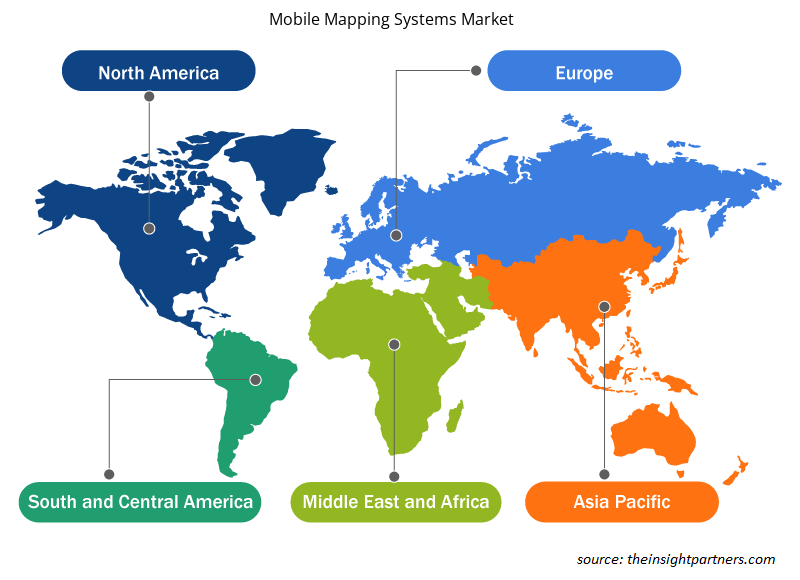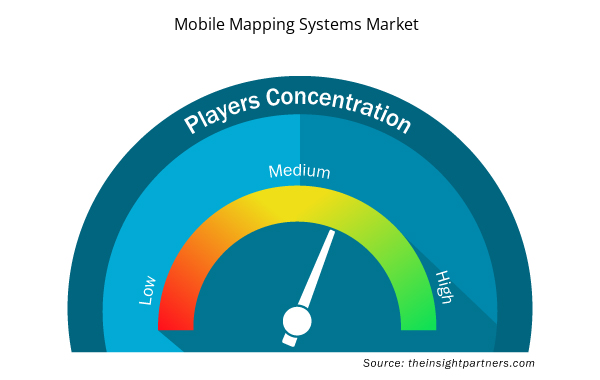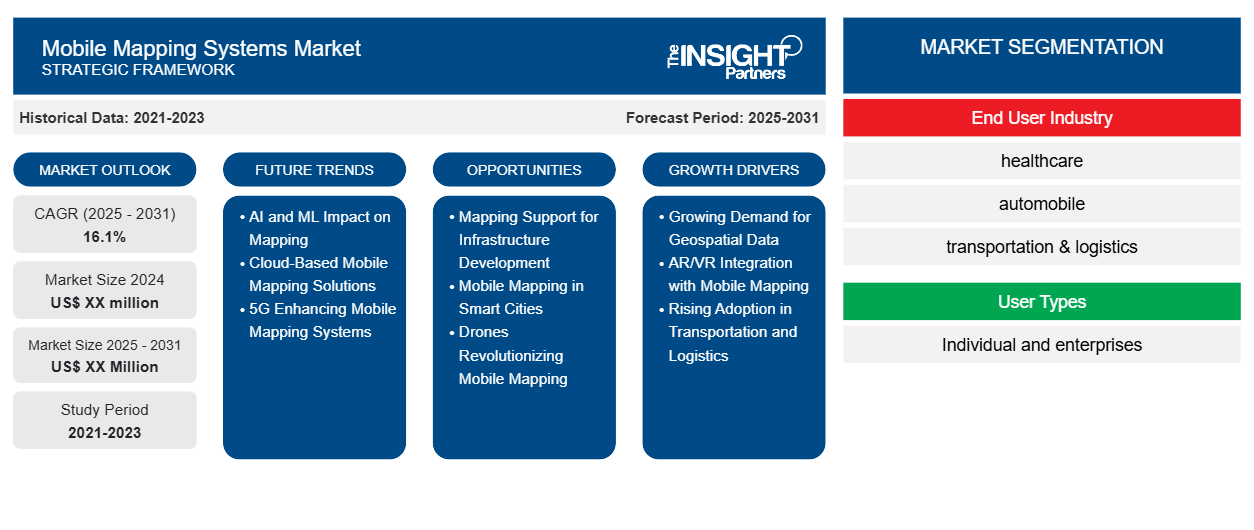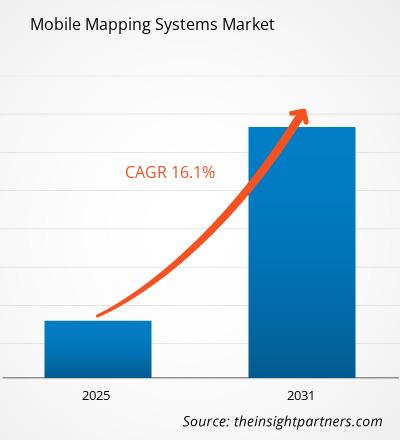Se espera que el mercado de sistemas de mapeo móvil registre una CAGR del 16,1% entre 2024 y 2031, con un tamaño de mercado que se expandirá de US$ XX millones en 2024 a US$ XX millones en 2031.
El informe de mercado de sistemas de mapeo móvil está segmentado en función de los servicios, la industria del usuario final y los tipos de usuario. El análisis global se desglosa aún más a nivel regional y por países principales. El informe ofrece el valor en dólares estadounidenses para el análisis y los segmentos anteriores.
Propósito del Informe
El informe Mobile Mapping Systems Market de The Insight Partners tiene como objetivo describir el panorama actual y el crecimiento futuro, los principales factores impulsores, los desafíos y las oportunidades. Esto proporcionará información a diversas partes interesadas del negocio, como:
- Proveedores/fabricantes de tecnología: Para comprender la dinámica cambiante del mercado y conocer las oportunidades potenciales de crecimiento, lo que les permitirá tomar decisiones estratégicas informadas.
- Inversionistas: Realizar un análisis exhaustivo de tendencias sobre la tasa de crecimiento del mercado, las proyecciones financieras del mercado y las oportunidades que existen en toda la cadena de valor.
- Órganos reguladores: Regular las políticas y vigilar las actividades del mercado con el objetivo de minimizar los abusos, preservar la confianza de los inversores y defender la integridad y la estabilidad del mercado.
Segmentación del mercado de sistemas de mapeo móvil
Industria del usuario final
- cuidado de la salud
- automóvil
- Transporte y logística
- Gobierno y sector público
- entretenimiento en video
- bienes raíces
- viajes y hostelería y construcción
Tipos de usuarios
- Individuos y empresas
Servicios
- Servicios basados en la ubicación
- Búsqueda basada en la ubicación
- Mapeo 3D
- Suscripción y soporte para cartografía y licencias en interiores
Geografía
- América del norte
- Europa
- Asia-Pacífico
- América del Sur y Central
- Oriente Medio y África
Personalice este informe según sus necesidades
Obtendrá personalización en cualquier informe, sin cargo, incluidas partes de este informe o análisis a nivel de país, paquete de datos de Excel, así como también grandes ofertas y descuentos para empresas emergentes y universidades.
- Obtenga las principales tendencias clave del mercado de este informe.Esta muestra GRATUITA incluirá análisis de datos, desde tendencias del mercado hasta estimaciones y pronósticos.
Factores impulsores del crecimiento del mercado de sistemas de mapeo móvil
- Demanda creciente de datos geoespaciales: los datos geoespaciales precisos son un factor importante en el mercado de los sistemas de mapeo móvil. Industrias como la planificación urbana, el transporte, la agricultura y la gestión de desastres dependen de las decisiones basadas en datos; por lo tanto, la demanda de datos geoespaciales está creciendo rápidamente. Los sistemas de mapeo móvil brindan datos de alta resolución que permiten realizar análisis en tiempo real y obtener información basada en la ubicación.
- Integración de AR/VR con mapeo móvil: la tecnología en evolución y el potencial de combinar AR/VR con sistemas de mapeo móvil ofrecen un enorme campo de oportunidades, especialmente para el sector de los videojuegos, el turismo y el sector inmobiliario. Las aplicaciones de AR superponen información digital sobre la vista real de los entornos físicos; los datos cartográficos de alta precisión complementarán la experiencia anterior. El sector inmobiliario utiliza VR para realizar recorridos virtuales de propiedades, que requieren un buen mapeo 3D.
- Creciente adopción en el sector del transporte y la logística: El sector del transporte y la logística utiliza cada vez más sistemas de mapeo móvil para optimizar sus operaciones y mejorar la eficiencia. La optimización de rutas, el seguimiento de activos y la inspección de infraestructura son algunas de las aplicaciones más críticas que estos sistemas desempeñan en el sector. Por ejemplo, los sistemas de mapeo móvil pueden crear mapas detallados para vehículos autónomos, lo que les permite navegar de forma segura y tomar decisiones en tiempo real. Las empresas de logística también utilizan los sistemas para agilizar los procesos de entrega y monitorear los movimientos de la flota. Con el mayor enfoque en el transporte sostenible y la logística inteligente, los sistemas de mapeo móvil se convierten en una herramienta esencial para lograr la excelencia operativa. También se espera que esta tendencia impulse el mercado con un gran crecimiento debido a la necesidad de soluciones de transporte y logística eficientes que siguen creciendo.
Tendencias futuras del mercado de sistemas de mapeo móvil
- El impacto de la IA y el ML en la cartografía: la IA y el ML han revolucionado la industria de la cartografía móvil. El análisis de datos está automatizado y la información recopilada es mucho más precisa con los métodos de IA y ML en comparación con los métodos tradicionales. Un algoritmo de IA es más rápido en comparación con los métodos tradicionales a la hora de procesar grandes conjuntos de datos, lo que proporciona información sobre patrones, junto con un análisis predictivo, que nunca se podría lograr de otra manera.
- Soluciones de mapeo móvil basadas en la nube: Las soluciones de mapeo basadas en la nube han surgido como la nueva cara de la industria del mapeo móvil. La tecnología en la nube ofrece capacidades de almacenamiento y procesamiento escalables: el almacenamiento y análisis de grandes cantidades de datos geoespaciales ahora es directamente posible sin la necesidad de desarrollar ninguna infraestructura local. Esta tendencia permitirá compartir información y colaborar en tiempo real y resulta muy útil para las industrias de la construcción cuyas partes interesadas necesitan poder acceder a mapas actualizados. La integración de la nube con el mapeo móvil reduce los costos operativos y hace que los datos sean más accesibles.
- 5G mejora los sistemas de mapeo móvil: se puede anticipar una transformación significativa de la industria del mapeo móvil en conjunto con las redes 5G. Los sistemas de mapeo móvil podrían procesar datos de mayor densidad de 5G, como mapas de alta definición e información en tiempo real, cambiando así la naturaleza de varias industrias dependientes geoespacialmente que dependen de información geográfica precisa y actualizada.
Oportunidades de mercado para sistemas de mapeo móvil
- Apoyo cartográfico para el desarrollo de infraestructuras: muchos países en desarrollo invierten mucho en el desarrollo de infraestructuras, como carreteras, ferrocarriles y planificación urbana, que exigen mapas detallados y datos geoespaciales; por ello, los sistemas de cartografía móvil pueden ayudar a los gobiernos y organizaciones de estas regiones a planificar de manera eficiente y distribuir adecuadamente los recursos y gestionar los desastres. Las empresas que se interesen por estas geografías incipientes pueden hacerse rápidamente con un mercado enorme y sin explotar, abriendo así nuevas vías para obtener ingresos.
- Mapeo móvil en ciudades inteligentes: Con la rápida urbanización y la creciente influencia de las ciudades inteligentes, el concepto ya no puede ignorarse. Los sistemas de mapeo móvil son fundamentales para construir infraestructuras de ciudades inteligentes al proporcionar información espacial confiable en tiempo real, que ayuda a gestionar redes de transporte, servicios públicos y servicios de emergencia. El auge brinda a los proveedores de sistemas de mapeo la capacidad de cooperar con los gobiernos nacionales y las autoridades locales en el diseño de soluciones integrales para proyectos de ciudades inteligentes, facilitando así el crecimiento sostenible del mercado a largo plazo.
- Los drones están revolucionando la cartografía móvil: los drones están revolucionando la perspectiva de la cartografía móvil, proporcionando nuevas funcionalidades en la adquisición de datos, como paisajes remotos, sitios de construcción y zonas de desastre. Dado el avance de la tecnología de los drones y la naturaleza cambiante de las políticas regulatorias, es probable que los sistemas de cartografía móvil basados en drones se apliquen en una gran cantidad de emprendimientos comerciales, lo que brindará a estas empresas nuevas vías de crecimiento.
Perspectivas regionales del mercado de sistemas de mapeo móvil
Los analistas de Insight Partners explicaron en detalle las tendencias y los factores regionales que influyen en el mercado de sistemas de mapeo móvil durante el período de pronóstico. Esta sección también analiza los segmentos y la geografía del mercado de sistemas de mapeo móvil en América del Norte, Europa, Asia Pacífico, Medio Oriente y África, y América del Sur y Central.

- Obtenga datos regionales específicos para el mercado de sistemas de mapeo móvil
Alcance del informe de mercado de sistemas de mapeo móvil
| Atributo del informe | Detalles |
|---|---|
| Tamaño del mercado en 2024 | XX millones de dólares estadounidenses |
| Tamaño del mercado en 2031 | US$ XX millones |
| Tasa de crecimiento anual compuesta (CAGR) global (2025-2031) | 16,1% |
| Datos históricos | 2021-2023 |
| Período de pronóstico | 2025-2031 |
| Segmentos cubiertos | Por industria del usuario final
|
| Regiones y países cubiertos | América del norte
|
| Líderes del mercado y perfiles de empresas clave |
|
Densidad de actores del mercado de sistemas de mapeo móvil: comprensión de su impacto en la dinámica empresarial
El mercado de sistemas de mapeo móvil está creciendo rápidamente, impulsado por la creciente demanda de los usuarios finales debido a factores como la evolución de las preferencias de los consumidores, los avances tecnológicos y una mayor conciencia de los beneficios del producto. A medida que aumenta la demanda, las empresas amplían sus ofertas, innovan para satisfacer las necesidades de los consumidores y aprovechan las tendencias emergentes, lo que impulsa aún más el crecimiento del mercado.
La densidad de actores del mercado se refiere a la distribución de las empresas o firmas que operan dentro de un mercado o industria en particular. Indica cuántos competidores (actores del mercado) están presentes en un espacio de mercado determinado en relación con su tamaño o valor total de mercado.
Las principales empresas que operan en el mercado de sistemas de mapeo móvil son:
- Google, Inc
- Corporación Microsoft
- Apple, Inc.
- Laboratorios Foursquare, Inc.
- Ericsson
Descargo de responsabilidad : Las empresas enumeradas anteriormente no están clasificadas en ningún orden particular.

- Obtenga una descripción general de los principales actores clave del mercado de sistemas de mapeo móvil
Puntos de venta clave
- Cobertura integral: el informe cubre de manera integral el análisis de productos, servicios, tipos y usuarios finales del mercado de sistemas de mapeo móvil, proporcionando un panorama holístico.
- Análisis de expertos: el informe se compila sobre la base de un profundo conocimiento de expertos y analistas de la industria.
- Información actualizada: El informe asegura relevancia comercial debido a su cobertura de información reciente y tendencias de datos.
- Opciones de personalización: este informe se puede personalizar para satisfacer los requisitos específicos del cliente y adaptarse adecuadamente a las estrategias comerciales.
Por lo tanto, el informe de investigación sobre el mercado de sistemas de mapeo móvil puede ayudar a abrir camino para descifrar y comprender el escenario de la industria y las perspectivas de crecimiento. Si bien puede haber algunas preocupaciones válidas, los beneficios generales de este informe tienden a superar las desventajas.
- Análisis histórico (2 años), año base, pronóstico (7 años) con CAGR
- Análisis PEST y FODA
- Tamaño del mercado Valor/volumen: global, regional, nacional
- Industria y panorama competitivo
- Conjunto de datos de Excel


- Artwork Management Software Market
- Medical Enzyme Technology Market
- Machine Condition Monitoring Market
- Cell Line Development Market
- Occupational Health Market
- Resistance Bands Market
- Industrial Valves Market
- Health Economics and Outcome Research (HEOR) Services Market
- Dry Eye Products Market
- Enteral Nutrition Market

Report Coverage
Revenue forecast, Company Analysis, Industry landscape, Growth factors, and Trends

Segment Covered
This text is related
to segments covered.

Regional Scope
North America, Europe, Asia Pacific, Middle East & Africa, South & Central America

Country Scope
This text is related
to country scope.
Preguntas frecuentes
Some of the customization options available based on request are additional 3-5 company profiles and country-specific analysis of 3-5 countries of your choice. Customizations are to be requested/discussed before making final order confirmation, as our team would review the same and check the feasibility.
The report can be delivered in PDF/PPT format; we can also share excel dataset based on the request.
Key companies in this market are: Google, Inc., Microsoft Corporation, Apple, Inc., Foursquare Labs, Inc., Ericsson, Tomtom NV, Trimble Navigation Ltd., Telecommunications System, Inc., Qualcomm Atheros, Inc., Mapquest, Inc.
The Mobile Mapping Systems Market is expected to register a CAGR of 16.1% from 2023-2031.
Key future trends in this market are - the integration of AI and ML for audience targeting and ad placement optimization through real-time data analysis, streamlining ad operations via AI-driven automation, and enhancing ecosystem efficiency and intelligence.
The primary driving factors of the market are - Accurate geospatial data, evolving technology, and the potential of combining AR/VR with mobile mapping systems.
Trends and growth analysis reports related to Technology, Media and Telecommunications : READ MORE..
- Google, Inc
- Microsoft Corporation
- Apple, Inc.
- Foursquare Labs, Inc
- Ericsson
- Tomtom NV
- Trimble Navigation Ltd.
- Telecommunications System, Inc.
- Qualcomm Atheros, Inc.
- Mapquest, Inc.
The Insight Partners performs research in 4 major stages: Data Collection & Secondary Research, Primary Research, Data Analysis and Data Triangulation & Final Review.
- Data Collection and Secondary Research:
As a market research and consulting firm operating from a decade, we have published and advised several client across the globe. First step for any study will start with an assessment of currently available data and insights from existing reports. Further, historical and current market information is collected from Investor Presentations, Annual Reports, SEC Filings, etc., and other information related to company’s performance and market positioning are gathered from Paid Databases (Factiva, Hoovers, and Reuters) and various other publications available in public domain.
Several associations trade associates, technical forums, institutes, societies and organization are accessed to gain technical as well as market related insights through their publications such as research papers, blogs and press releases related to the studies are referred to get cues about the market. Further, white papers, journals, magazines, and other news articles published in last 3 years are scrutinized and analyzed to understand the current market trends.
- Primary Research:
The primarily interview analysis comprise of data obtained from industry participants interview and answers to survey questions gathered by in-house primary team.
For primary research, interviews are conducted with industry experts/CEOs/Marketing Managers/VPs/Subject Matter Experts from both demand and supply side to get a 360-degree view of the market. The primary team conducts several interviews based on the complexity of the markets to understand the various market trends and dynamics which makes research more credible and precise.
A typical research interview fulfils the following functions:
- Provides first-hand information on the market size, market trends, growth trends, competitive landscape, and outlook
- Validates and strengthens in-house secondary research findings
- Develops the analysis team’s expertise and market understanding
Primary research involves email interactions and telephone interviews for each market, category, segment, and sub-segment across geographies. The participants who typically take part in such a process include, but are not limited to:
- Industry participants: VPs, business development managers, market intelligence managers and national sales managers
- Outside experts: Valuation experts, research analysts and key opinion leaders specializing in the electronics and semiconductor industry.
Below is the breakup of our primary respondents by company, designation, and region:

Once we receive the confirmation from primary research sources or primary respondents, we finalize the base year market estimation and forecast the data as per the macroeconomic and microeconomic factors assessed during data collection.
- Data Analysis:
Once data is validated through both secondary as well as primary respondents, we finalize the market estimations by hypothesis formulation and factor analysis at regional and country level.
- Macro-Economic Factor Analysis:
We analyse macroeconomic indicators such the gross domestic product (GDP), increase in the demand for goods and services across industries, technological advancement, regional economic growth, governmental policies, the influence of COVID-19, PEST analysis, and other aspects. This analysis aids in setting benchmarks for various nations/regions and approximating market splits. Additionally, the general trend of the aforementioned components aid in determining the market's development possibilities.
- Country Level Data:
Various factors that are especially aligned to the country are taken into account to determine the market size for a certain area and country, including the presence of vendors, such as headquarters and offices, the country's GDP, demand patterns, and industry growth. To comprehend the market dynamics for the nation, a number of growth variables, inhibitors, application areas, and current market trends are researched. The aforementioned elements aid in determining the country's overall market's growth potential.
- Company Profile:
The “Table of Contents” is formulated by listing and analyzing more than 25 - 30 companies operating in the market ecosystem across geographies. However, we profile only 10 companies as a standard practice in our syndicate reports. These 10 companies comprise leading, emerging, and regional players. Nonetheless, our analysis is not restricted to the 10 listed companies, we also analyze other companies present in the market to develop a holistic view and understand the prevailing trends. The “Company Profiles” section in the report covers key facts, business description, products & services, financial information, SWOT analysis, and key developments. The financial information presented is extracted from the annual reports and official documents of the publicly listed companies. Upon collecting the information for the sections of respective companies, we verify them via various primary sources and then compile the data in respective company profiles. The company level information helps us in deriving the base number as well as in forecasting the market size.
- Developing Base Number:
Aggregation of sales statistics (2020-2022) and macro-economic factor, and other secondary and primary research insights are utilized to arrive at base number and related market shares for 2022. The data gaps are identified in this step and relevant market data is analyzed, collected from paid primary interviews or databases. On finalizing the base year market size, forecasts are developed on the basis of macro-economic, industry and market growth factors and company level analysis.
- Data Triangulation and Final Review:
The market findings and base year market size calculations are validated from supply as well as demand side. Demand side validations are based on macro-economic factor analysis and benchmarks for respective regions and countries. In case of supply side validations, revenues of major companies are estimated (in case not available) based on industry benchmark, approximate number of employees, product portfolio, and primary interviews revenues are gathered. Further revenue from target product/service segment is assessed to avoid overshooting of market statistics. In case of heavy deviations between supply and demand side values, all thes steps are repeated to achieve synchronization.
We follow an iterative model, wherein we share our research findings with Subject Matter Experts (SME’s) and Key Opinion Leaders (KOLs) until consensus view of the market is not formulated – this model negates any drastic deviation in the opinions of experts. Only validated and universally acceptable research findings are quoted in our reports.
We have important check points that we use to validate our research findings – which we call – data triangulation, where we validate the information, we generate from secondary sources with primary interviews and then we re-validate with our internal data bases and Subject matter experts. This comprehensive model enables us to deliver high quality, reliable data in shortest possible time.


 Obtenga una muestra gratuita de este informe
Obtenga una muestra gratuita de este informe